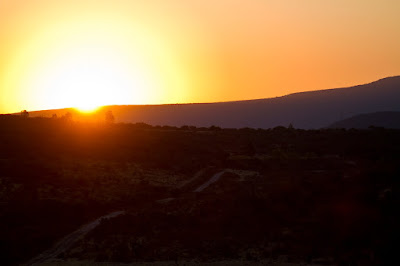The limits of conservation

While still planning the construction of this house, we received a terrific piece of advice from our friend Roger: Make sure one of the bedroom windows faces east, so you can enjoy, while still in bed, the daily spectacle of a sunrise. We've since read that's a pretty standard consideration when siting a house but we'd never thought of it until Roger mentioned it.
And so we did what he suggested. The master bedroom has two large windows, one facing east and the other south. Each morning the east-facing window frames a theatrical spectacle of color. The sky behind the mountains gradually turns a brighter shade of orange, as if someone on a light board were gently fiddling with different levers, knobs and switches. Naturally the basic colors are much the same each day yet the precise mix varies slightly from day to day, depending on the ground fog, haze, temperature, humidity or who knows what. The foreground--a winding road, farm fields of various shades of green and brown with a dry river bed cutting across--remains in the dark for about fifteen minutes into the light show, when the sun gradually reveals the rest of the scenery.
Thanks for the suggestion, Roger.
The other window faces south and though the views are not quite as dramatic, the sun streaming in the late morning warms up the room during the cold months. (One worthwhile idea that was never implemented was to install eaves about two feet wide over each south-facing window, like eyelashes, to shield the room from the early summer sun and heat. Instead we just pull down the blinds.)
The other suggestion from Roger didn't quite pan out: Get an ultra energy-efficient Bosch dishwasher. It turns out the Bosch is very frugal on water but a pig on electricity. The secret to Bosch's stingy consumption--a full load with as little as 2.5 gallons of water--apparently is that tiny sips of water get sloshed around interminably. The shortest cycle ("Rápido") goes on for an hour and the longer cycles can have the machine humming, and sucking electrical juice, for over two hours.
We rethought our use of the "Rápido" setting earlier this week when the dishes kept coming out half-clean. The hell with it, we decided, let's go for the "Auto" setting which lets some little computer chip inside the machine decide the "optimum" combination of water intake and length of the wash, up to a whopping 187 minutes. How the chip decides the level of grunginess is a mystery. I believe it has something to do with the turbidity of the water cycling around.
That in turn my depend on the cuisine involved in last night's dinner. Gooey, saucy Italian dishes are sure to trigger the extra-long penalty cycle, like a car wash struggling to scrub off cow pies stuck to the fenders of a pickup. The dishes from a more sensible dinner, say a petite nouvelle something-or-other, are more like a dusty Mini Cooper just needing a quick rinse. Despite increased salad and vegetable consumption from our garden, our diet still trends toward the gooey side.
Whatever it does, the Auto setting gets the dishes sparkling clean. As for conservation of electricity and water, we're sorry to report that we no longer care.
Hey but why should we be sorry? Under San Miguel's relentlessly sunny weather, the photovoltaic panels are generating a little more than 15 kilowatts a day, which is more than we need. As for tomorrow, there's bound to be more sun and more solar electricity, and the monthly bill will still be zero pesos. Three months away from the next rainy season, our rainwater collection cistern also remains about 85 percent full.
So for the time being, why conserve? There's no incentive. That is until it gets cloudy or we hit a drought. That could push us back on the conservation wagon--and pronto.

Your writing is an absolute delight!
ReplyDelete